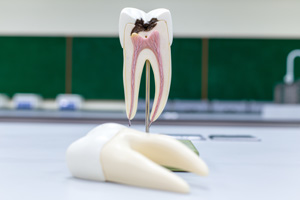 A root canal is needed when the pulp of a tooth becomes infected or dies. The tooth pulp is a soft tissue made up of nerves and blood vessels. It is contained in the pulp chamber that extends from the middle of the tooth down through the tooth roots. The pulp becomes infected when bacteria invade the inner layers of the tooth. This infection can be caused by a cracked tooth, deep untreated cavity, repeated dental treatment to the tooth or trauma.
A root canal is needed when the pulp of a tooth becomes infected or dies. The tooth pulp is a soft tissue made up of nerves and blood vessels. It is contained in the pulp chamber that extends from the middle of the tooth down through the tooth roots. The pulp becomes infected when bacteria invade the inner layers of the tooth. This infection can be caused by a cracked tooth, deep untreated cavity, repeated dental treatment to the tooth or trauma.
Symptoms of Infection
The following are symptoms that may indicate you have an infected tooth:
- The tooth is sensitive to hot or cold
- The tooth hurts with biting or pressure
- There is throbbing and/or severe tooth pain
- The area is swollen
- You have a bad taste in your mouth
The Root Canal Procedure
A root canal procedure removes the infection or damaged area of the tooth (pulp) in the tooth’s root in order to save the tooth. The area is cleaned and disinfected and then filled and sealed.
Dr. Fernandez will take an X-ray of your tooth to locate the infection or decay. Local anesthesia will be applied to the infected tooth. He will ensure the area is completely numb before beginning the root canal procedure.
Dr. Fernandez will use a very small drill to create an opening in the top of the tooth to access the decayed area inside the tooth’s root. He will clear out the infected and damaged pulp using small files. These files are also used to shape the inner chamber of the root. Irrigation may be used to clean any remaining pulp out of the root chamber. Depending on the infection, Dr. Fernandez may put an antimicrobial solution in the chamber to kill any remaining bacteria and reduce the risk of further infection. If the infection is severe, we may let the tooth heal after medication has been inserted and finish the root canal in a second appointment.
Once the chamber is completely cleaned and dried, Dr. Fernandez will fill it with a rubber-like material called gutta percha. The opening will be closed with a temporary filling.
Dr. Fernandez will finish the treatment in a couple of weeks by placing a permanent “crown” on the tooth. Depending on the condition of the tooth, it may be necessary to place a supporting post and core in the tooth root chamber to help stabilize the crown restoration.
Care After a Root Canal Procedure
- Practice good oral hygiene - brush twice a day and floss daily
- Visit our office for routine check-ups and cleanings
- Avoid chewing on hard foods, such as ice and hard candy, which can damage root canaled teeth
Call our office with any questions or concerns. With proper care and maintenance, you can keep a tooth with a root canal healthy for a lifetime.

